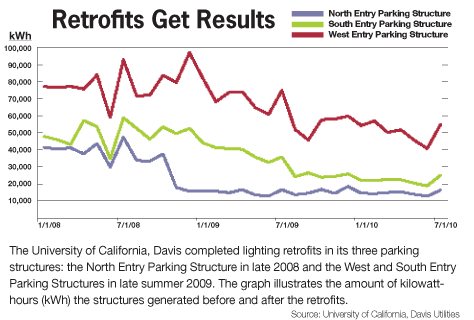Lighting Retrofits: Bi-Level Induction Lamps Reliable, Efficient
Parking structures provided the university with a significant opportunity for savings, due to their 24-7 nature on a campus with predictable occupancy. Bi-level induction lamps specified for the structures eased the installation workload because the circuits and spacing for the fixtures already were in place, Cioni says.
"We were looking for something where we would basically replace a fixture — pull one down and replace it in kind — without having to add additional fixtures," he says. "With a concrete parking structure, you can imagine the work that would be involved if you wanted to modify that."
In addition to streamlining fixture installation, induction lighting also provided an established technology that improves reliability. The tube in the induction fixture is completely enclosed, and, unlike tube fluorescent lights, induction lamps do not have prongs on the end of the lamp. Cioni says the prongs on the fluorescent tubes fail over time because they act as spark plugs to excite the gas inside the tube.
By not having the prongs featured on the fluorescent tubes, the university eliminated the opportunity for mechanical failure by specifying induction lighting, Cioni says.
The bi-level component of the induction lighting is related to occupancy. The lamps produce half output when the space is unoccupied and full output when occupied. The bi-level induction lamps feature passive-infrared occupancy sensors, as well as dimmable ballasts.
The bi-level and control technologies have helped generate significant savings for the university. For example, in the North Entry Parking Structure, the number of kilowatt-hours (kWh) generated in October 2008 was 37,500 kWh. After completing the retrofit, that number dropped to about 18,000 kWh for November and less than 16,000 kWh for December (see the graph below).

Related Topics:















